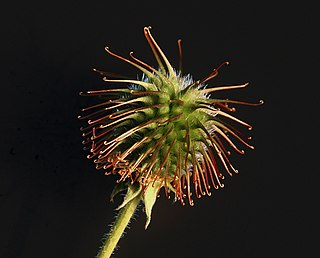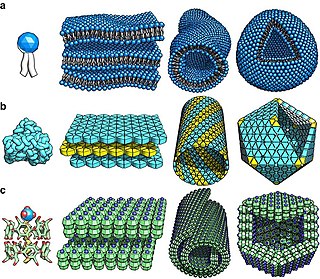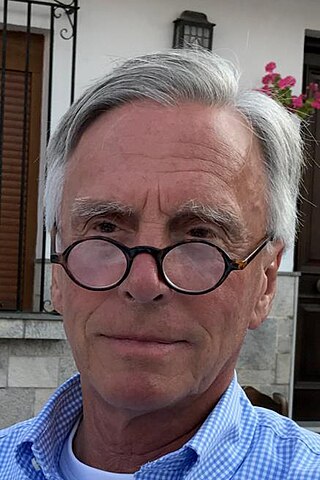
Biomimetics or biomimicry is the emulation of the models, systems, and elements of nature for the purpose of solving complex human problems. The terms "biomimetics" and "biomimicry" are derived from Ancient Greek: βίος (bios), life, and μίμησις (mīmēsis), imitation, from μιμεῖσθαι (mīmeisthai), to imitate, from μῖμος (mimos), actor. A closely related field is bionics.

Self-assembly is a process in which a disordered system of pre-existing components forms an organized structure or pattern as a consequence of specific, local interactions among the components themselves, without external direction. When the constitutive components are molecules, the process is termed molecular self-assembly.

An artificial enzyme is a synthetic organic molecule or ion that recreates one or more functions of an enzyme. It seeks to deliver catalysis at rates and selectivity observed in naturally occurring enzymes.
Layer-by-layer (LbL) deposition is a thin film fabrication technique. The films are formed by depositing alternating layers of oppositely charged materials with wash steps in between. This can be accomplished by using various techniques such as immersion, spin, spray, electromagnetism, or fluidics.

Nanocellulose is a term referring to nano-structured cellulose. This may be either cellulose nanocrystal, cellulose nanofibers (CNF) also called nanofibrillated cellulose (NFC), or bacterial nanocellulose, which refers to nano-structured cellulose produced by bacteria.

Samuel I. Stupp, is a Board of Trustees Professor of Materials Science, Chemistry, and Medicine at Northwestern University in Chicago, IL. He is best known for his work on self-assembling materials and supramolecular chemistry. One of his most notable discoveries is a broad class of peptide amphiphiles that self-assemble into high aspect ratio nanofibers with extensive applications in regenerative medicine. He has also made significant contributions to the fields of supramolecular chemistry, nanotechnology, and organic electronic materials. He has over 500 peer-reviewed publications and was one of the 100 most cited chemists in the 2000–2010 decade.

Sharon C. Glotzer is an American scientist and "digital alchemist", the Anthony C. Lembke Department Chair of Chemical Engineering, the John Werner Cahn Distinguished University Professor of Engineering and the Stuart W. Churchill Collegiate Professor of Chemical Engineering at the University of Michigan, where she is also professor of materials science and engineering, professor of physics, professor of macromolecular science and engineering, and professor of applied physics. She is recognized for her contributions to the fields of soft matter and computational science, most notably on problems in assembly science and engineering, nanoscience, and the glass transition, for which the elucidation of the nature of dynamical heterogeneity in glassy liquids is of particular significance. She is a member of the National Academy of Sciences, the National Academy of Engineering, and the American Academy of Arts and Sciences.

Ayyappanpillai Ajayaghosh is a research scientist/academician in the domain of interdisciplinary chemistry, and the former Director of the National Institute for Interdisciplinary Science and Technology. He is known for his studies on supramolecular assemblies, organogels, photoresponsive materials, chemosensory and security materials systems and is an elected fellow of all the three major Indian science academies viz. the National Academy of Sciences, India, Indian National Science Academy and the Indian Academy of Sciences as well as The World Academy of Sciences. The Council of Scientific and Industrial Research, the apex agency of the Government of India for scientific research, awarded him the Shanti Swarup Bhatnagar Prize for Science and Technology, one of the highest Indian science awards for his contributions to Chemical Sciences in 2007. He is the first chemist to receive the Infosys Science Prize for physical sciences, awarded by the Infosys Science Foundation. He received the TWAS Prize of The World Academy of Sciences in 2013 and the Goyal prize in 2019.

Nanoparticles are classified as having at least one of its dimensions in the range of 1-100 nanometers (nm). The small size of nanoparticles allows them to have unique characteristics which may not be possible on the macro-scale. Self-assembly is the spontaneous organization of smaller subunits to form larger, well-organized patterns. For nanoparticles, this spontaneous assembly is a consequence of interactions between the particles aimed at achieving a thermodynamic equilibrium and reducing the system’s free energy. The thermodynamics definition of self-assembly was introduced by Professor Nicholas A. Kotov. He describes self-assembly as a process where components of the system acquire non-random spatial distribution with respect to each other and the boundaries of the system. This definition allows one to account for mass and energy fluxes taking place in the self-assembly processes.
A nanosheet is a two-dimensional nanostructure with thickness in a scale ranging from 1 to 100 nm.
Stephen Mann, FRS, FRSC, is Professor of Chemistry, co-director of the Max Planck Bristol Centre for Minimal Biology, director of the Centre for Organized Matter Chemistry, director of the Centre for Protolife Research, and was principal of the Bristol Centre for Functional Nanomaterials at the University of Bristol, UK.
Niveen M. Khashab is a Lebanese chemist and an associate Professor of chemical Sciences and engineering at King Abdullah University of Science and Technology in Saudi Arabia since 2009. She is a laureate of the 2017 L'Oréal-UNESCO Awards for Women in Science "for her contributions to innovative smart hybrid materials aimed at drug delivery and for developing new techniques to monitor intracellular antioxidant activity." She is also a fellow of the Royal Chemical Society, and a member of the American Chemical Society.

Orlin D. Velev is the INVISTA Professor in the Department of Chemical and Biomolecular Engineering at North Carolina State University. He is best known for his work in soft matter, colloid science, and nanoscience.

Irshad Hussain is a Pakistani Scientist in the field of chemistry and among the few pioneers to initiate nanomaterials research in Pakistan.
Fiona C. Meldrum is a British scientist who is a Professor of Inorganic Chemistry at the University of Leeds where she works on bio-inspired materials and crystallisation processes. She won the 2017 Royal Society of Chemistry Interdisciplinary Prize.
So-Jung Park 박소정(朴昭靜) is a professor of chemistry at Ewha Womans University, Republic of Korea. Her research considers the self-assembly of nanoparticles and functional molecules for biomedical and optoelectronic devices. She serves as Associate Editor of ACS Applied Materials & Interfaces and Nanoscale.

Roeland J. M. Nolte is a Dutch chemist, known for his work in the fields of organic chemistry, biochemistry, polymer chemistry, and supramolecular chemistry. He is an emeritus Royal Netherlands of Arts and Sciences professor and an emeritus professor of Organic Chemistry at Radboud University in Nijmegen, The Netherlands. Currently, he holds a special chair, i.e. professor of Molecular Nanotechnology, at this university. Nolte is considered to be one of the pioneers of the field of supramolecular chemistry, which encompasses the design and synthesis of new chemical structures from low molecular weight compounds and biopolymers using so-called non-covalent interactions. He published many studies on supramolecular assembly and biomimetic catalysts, which find applications in the field of nanomaterials and medicine.
Stephanie Lee Brock is an American chemist who is professor of inorganic chemistry at Wayne State University. Her research considers transition metal pnictides and chalcogenide nanomaterials. She is a Fellow of the American Association for the Advancement of Science and the American Chemical Society.
Silvia Vignolini is an Italian physicist who is Director of research at the Max Planck Institute of Colloids and Interfaces and Professor of Chemistry and Bio-materials in the Yusuf Hamied Department of Chemistry at the University of Cambridge. Her research investigates natural photonics structures, the self-assembly of cellulose and light propagation through complex structures. She was awarded the KINGFA young investigator award by the American Chemical Society and the Gibson-Fawcett Award in 2018.
Christopher Bruce Murray is the Richard Perry University Professor of Chemistry and Materials Science and Engineering at the University of Pennsylvania. He is a member of the National Academy of Engineering and a Fellow of the Materials Research Society. He was a Clarivate Citation Laureate in 2020. He is known for his contributions to quantum dots and other nanoscale materials.











